By: Pei Ying Loh / 13 April 2020
We know that Southeast Asia has a plastic waste problem. Ever since the world’s largest importer of plastic trash, China, decided to stop bringing in this waste in 2017, much of it has landed on Southeast Asia. While a handful of Southeast Asian nations have continued to import plastic waste, the rest are refusing it in attempts to turn the tide on the issue.
Plastic waste by country, 2010

Although the top waste producers in the world (China, Germany, Brazil, and the US) are outside the region, an astonishing amount of ocean plastic comes from Southeast Asia. While China remains the largest contributor, major rivers from Southeast Asia account for a substantial amount.
Top 20 rivers contributing to ocean plastic, 2015
Rivers in red are all found in Southeast Asia
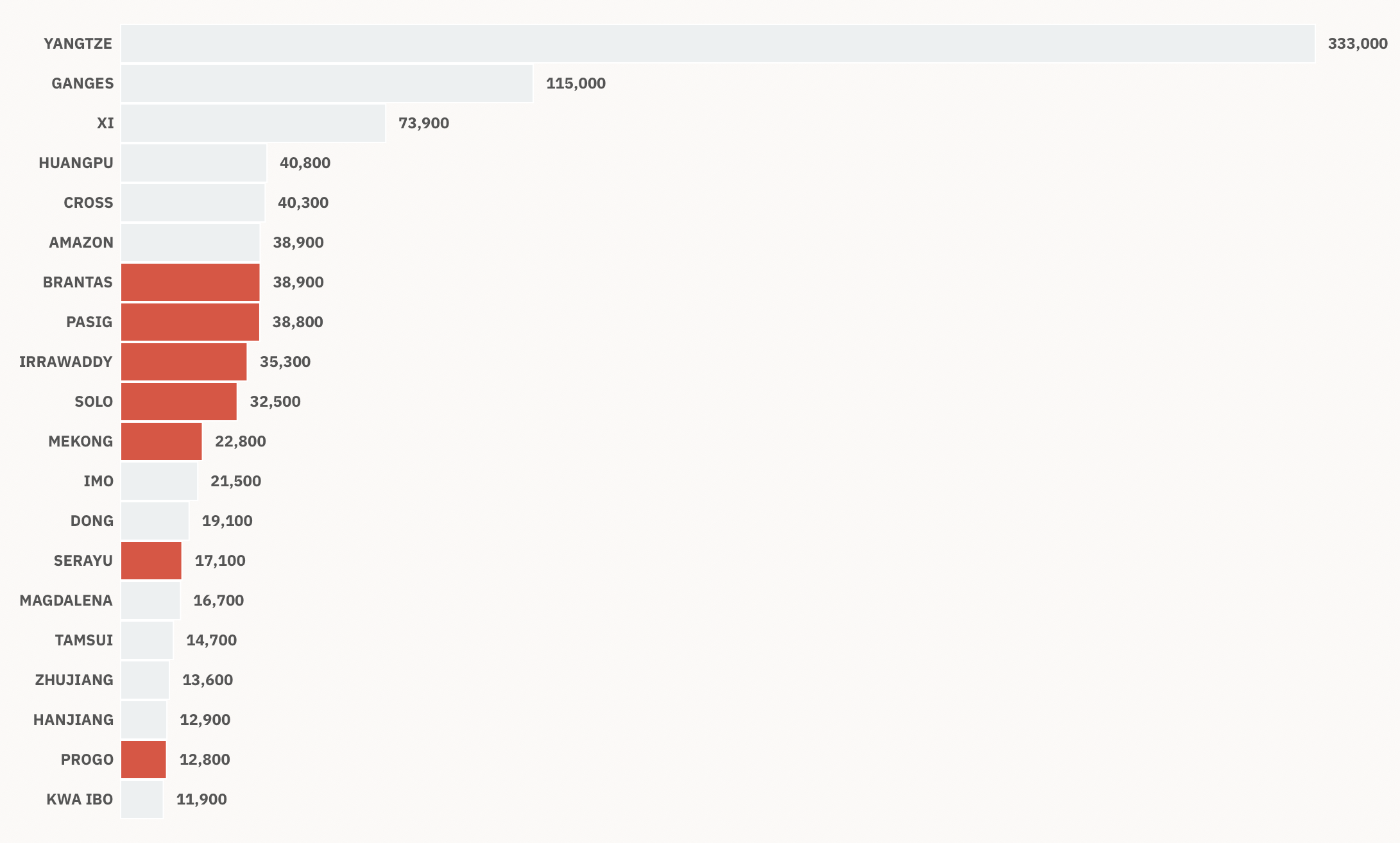
So, why does so much of Southeast Asia’s plastic end up in the ocean? The answer is obvious. Southeast Asia doesn’t just have a plastics problem—it has a huge waste problem.
What’s in Southeast Asia’s waste?
In the past few years, plastic use has received a lot of attention worldwide, in part due to the global #zerowaste movement. Even though people frequently call for plastic bans to reduce its presence in our rivers and oceans, ocean-bound plastic is merely a symptom of the region’s waste management problems.
Waste composition among Southeast Asian countries
Breakdown of municipal solid waste, 2016


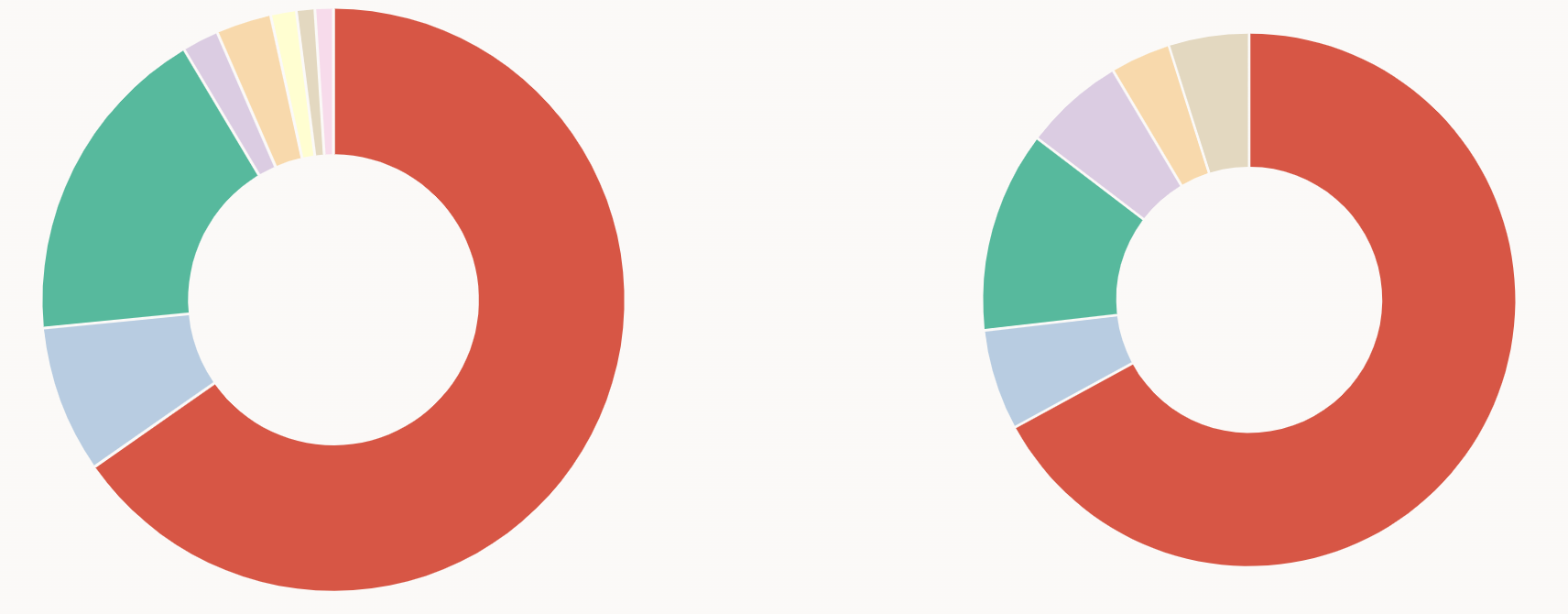
In fact, a closer look at the composition of Southeast Asia’s waste reveals that the region (Singapore excepting) has a far larger problem with food and organic waste than with plastics specifically. In a region well-known for large segments of communities that suffer from hunger, poverty, food insecurity, and malnutrition, it seems a pity that so much of its food is wasted.
Why is waste management in the region poor?
One obvious answer to this is geography. Studies have shown that countries with more populous coastlines are more likely to pollute the ocean with plastic. Indonesia, Philippines, and Vietnam, all of which have large coastal populations, each contribute more than 5 percent of the global share of mismanaged plastic. Even so, many other countries around the world, and even within Asia, have robust plastic management systems despite their long coastlines and dense coastal populations.
Mismanaged plastic waste by country, 2010
% share of global
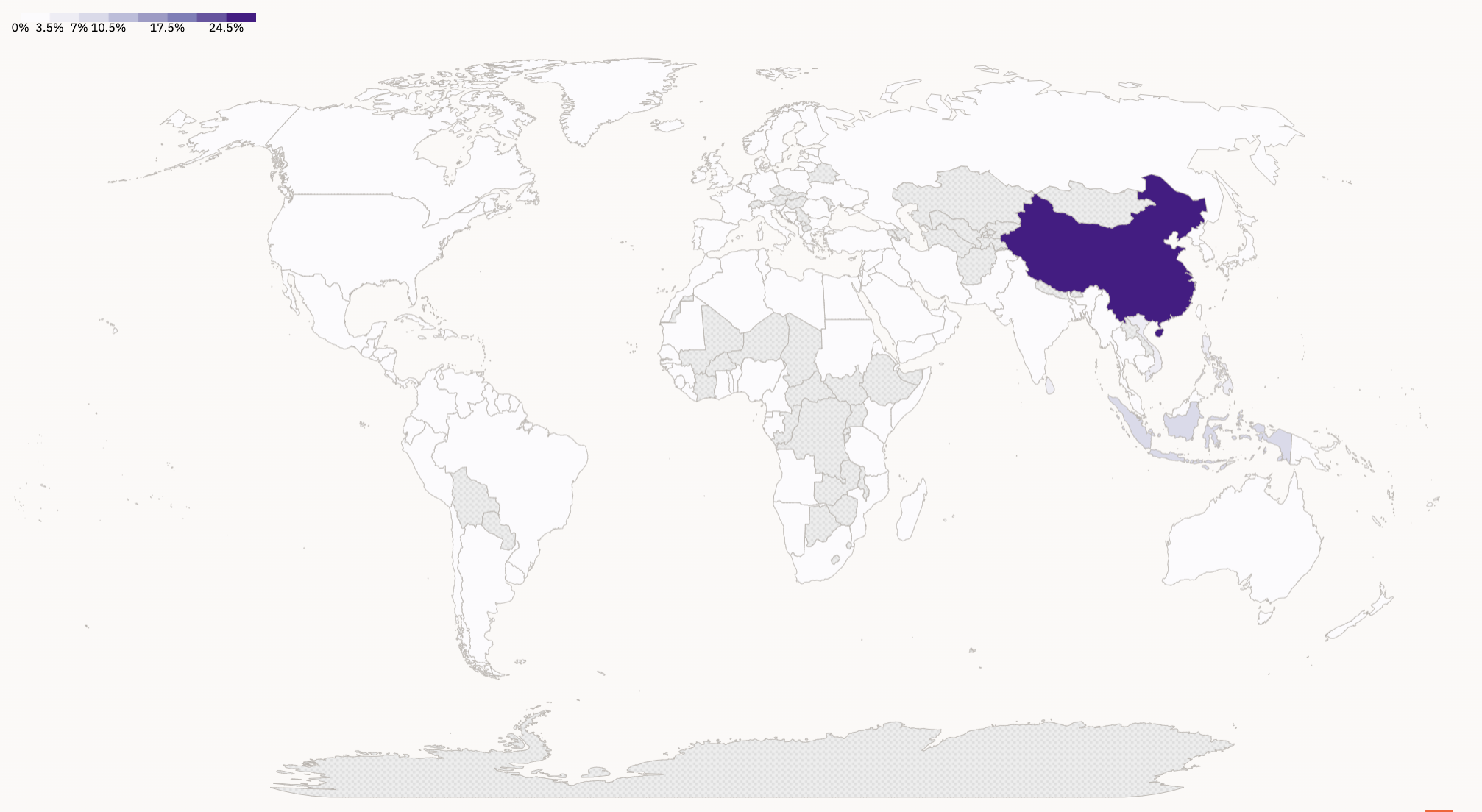
Another plausible explanation is that population growth and higher income levels might lead to more waste generation. However, the data show that this isn’t always the case across the board.
Waste generated by Southeast Asian countries
Compared against population and GDP per capita
Circle size determined by amount of municipal solid waste generated in tonnes based on data from 2016

It’s clear that Southeast Asia’s poor waste management has to do something far more specific than coastlines, population size, or income. The region’s recent history tells us that the largest waste-generating countries—Indonesia, Philippines, Vietnam, and Thailand—all experienced rapid urbanisation and purchasing power growth over the last three decades. This also explains why food takes up such a large proportion of the region’s waste. Traditional buying practices, in which people tend to buy a day’s worth of food each time from local sources, have been replaced by supermarket shopping, which encourages overbuying as well as food waste through long-distance transportation.
Southeast Asia’s poor waste management thus stems from lagging infrastructural development in the face of explosive economic growth and urbanisation. Considering how ASEAN’s urbanisation rate is expected to pass 70 percent by 2050, this crisis is likely to worsen in coming years.
Urbanisation and GDP per capita from 1990 to 2018
GDP per capita, PPP (current international $) and Annual percentage of population in urban areas
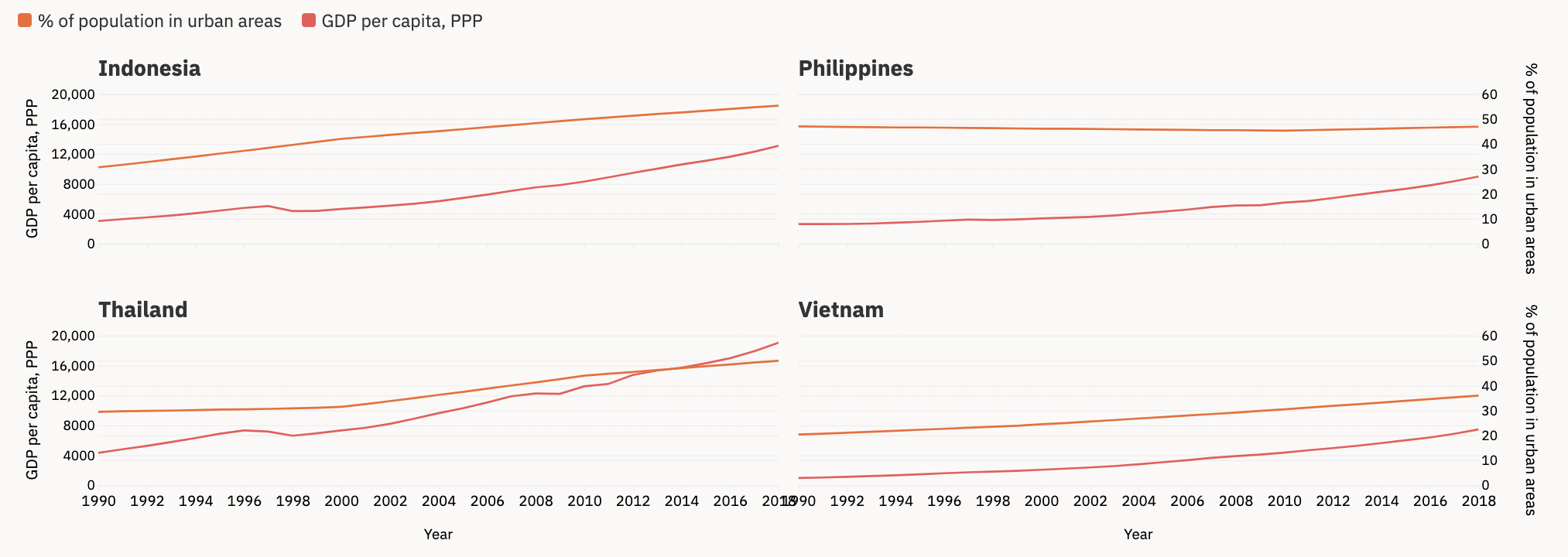
Source: World Bank, United Nations
Take, for example, the city of Jakarta. Despite being the most populous city in Southeast Asia at an estimated 10.8 million people, the city is only just beginning to construct its very first incinerator. It has only one waste solution—landfill. Bantar Gebang, Jakarta’s largest landfill (or, more accurately, its open dump) takes in nearly 7,000 tons of garbage each day.
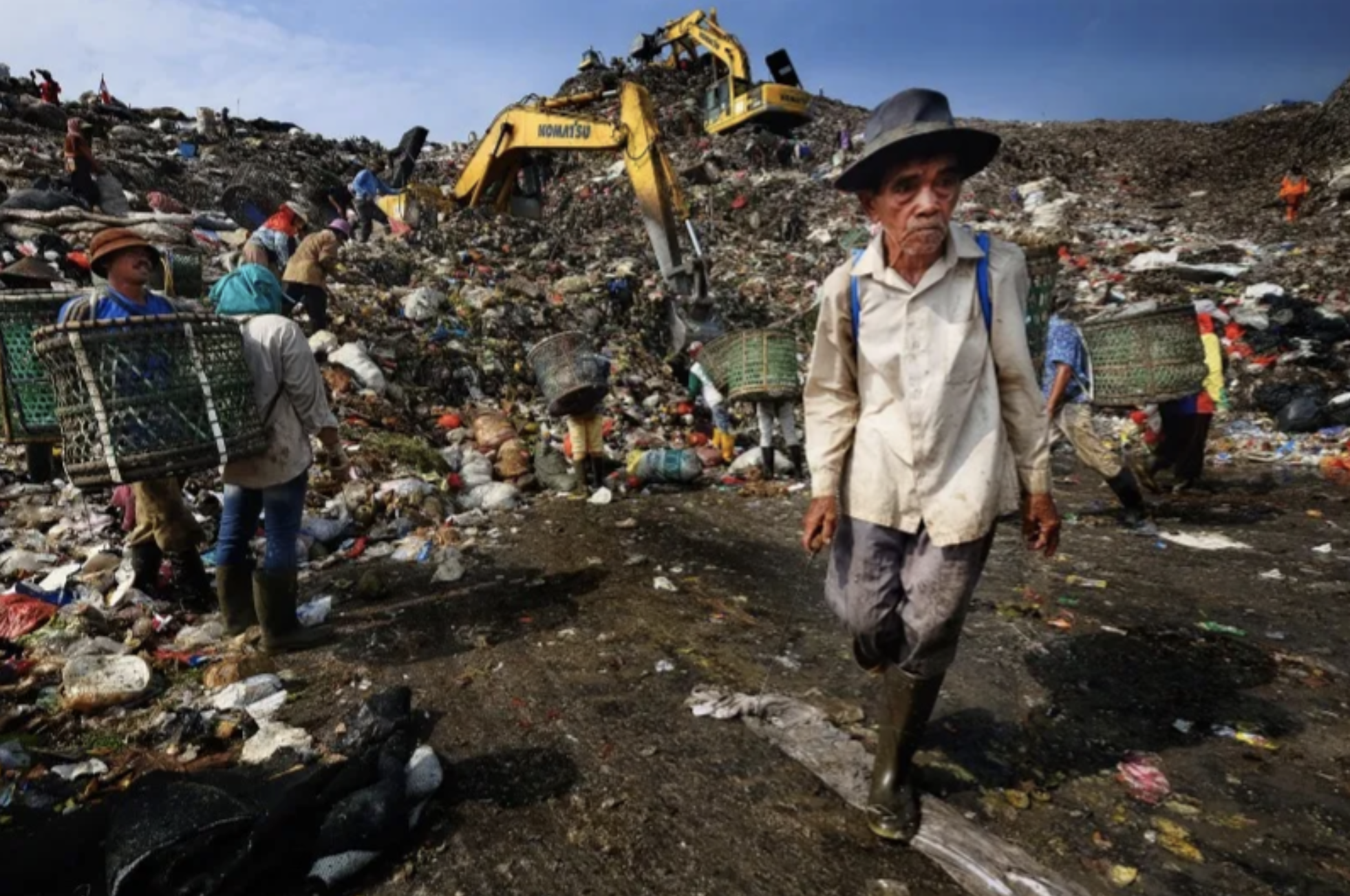
As Indonesia’s population grows in size and wealth, its waste situation is only worsening in comparison. Indonesia implemented a Waste Law in 2008 to control the spiralling situation. Even so, its sanitary landfills are increasingly being operated as unsanitary open dump sites, as authorities are unable to manage and maintain the sanitary landfills’ stricter standards. Needless to say, open dumps bring a wide range of problems to the communities around them, such as groundwater pollution and lingering odour.
A matter of lesser evils?
An ideal waste management system depends on several factors. The first crucial step is sorting waste at its source. This means households and individuals actively and consciously separate their waste, which then gets sent to various facilities for disposal or recycling. Organic and food waste is composted into reusable fertiliser.
Types of treatment for garbage in Southeast Asia
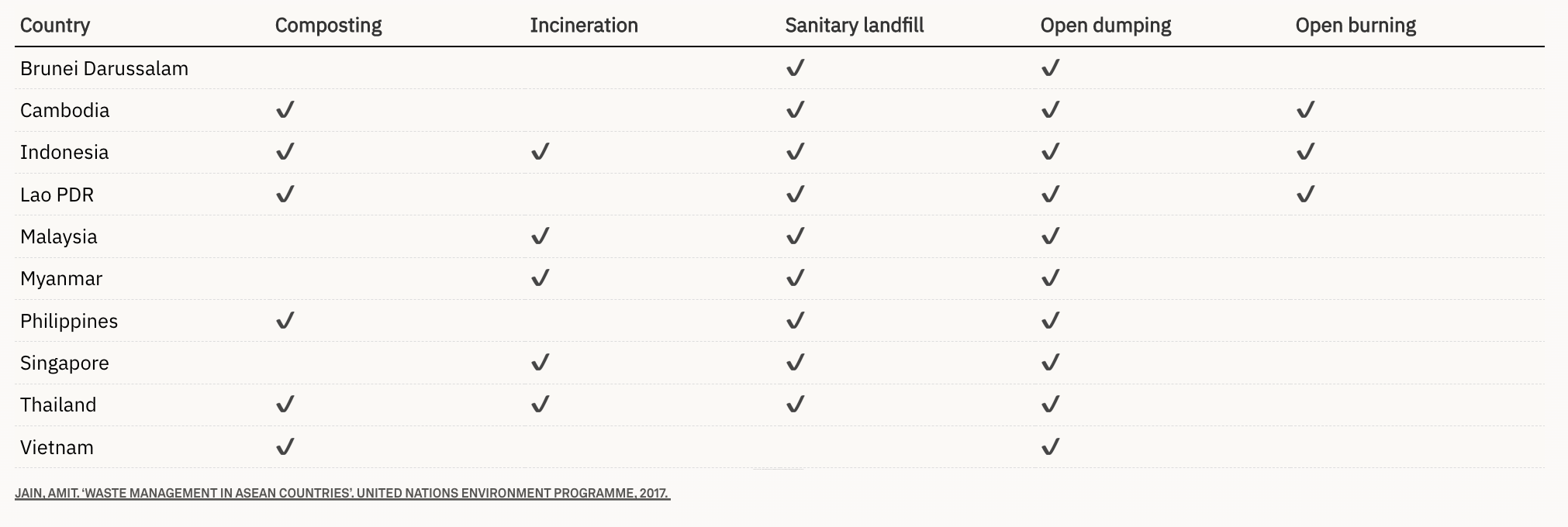
Unfortunately, Southeast Asia is far off the mark when it comes to recycling. Even in Singapore, which attempts to instil a habit of waste sorting at its source, most people don’t fully understand what constitutes recyclable waste, leading to a low recycling rate. The island nation also has just two main methods of waste disposal—sanitary landfill and incineration.
The recycling rate across Southeast Asia is less than 50 percent, and composting and incineration are practiced only in limited capacity. Landfills and open dumps are still very much preferred methods of disposal, and they come with a whole host of problems. Open dumps are extremely unsanitary, hazardous to the environment, and are dangerous to the health of those living around them. Landfills and open dumps are also unsustainable solutions, as space eventually runs out.
Incineration, then, appears to be the lesser evil. The Japan-led Asian Development Bank has been a strong proponent of “waste-to-energy” incineration as a waste management method. This solution takes care of the space concerns and also creates energy at the same time. But incineration has also been heavily criticised for being environmentally unsustainable—it is energy intensive and produces many pollutants.
Whether the region will turn to incineration as a main waste management solution remains to be seen. For developing nations, funding to invest in large projects is often scarce, and waste management infrastructure tends to rank lower in priority in national budgets.
What then?
If investing in large-scale infrastructure is not viable, what other options do Southeast Asian states have?
Community-based waste management systems are often suggested as a more feasible long-term solution. For example, Indonesia has attempted to tackle its waste problem by introducing a waste-bank program (bank sampah) in 2012. Households sort their trash into organic and non-organic waste, then deposit it in a central neighbourhood waste bank, which provides them monetary returns for their trash.
The Ocean Cleanup, a non-profit organisation focused on using technology to rid the ocean of plastic, has developed an innovative solution. While The Interceptor—a trash-eating barge that intercepts trash in rivers before it ends up in the ocean—is a very commendable effort, it still doesn’t resolve the system-wide waste management challenges that Southeast Asia faces.
Ultimately, waste management merely tackles symptoms rather than the causes of the problem. As mentioned, rapid urbanisation and rising purchasing power contribute to higher consumption rates—a worsening situation as middle-income groups in Southeast Asia grow exponentially. That said, increasing waste production is a global problem, and a handful of developed nations have taken to more drastic measures. The city of Vaud in Switzerland, for example, imposed a waste tax that saw a 40 percent reduction in waste produced.
While many countries have turned to educational programmes to raise awareness on consumption habits, this is unlikely to make a huge difference. After all, there is a distinct rich-poor divide between those who generate waste and those who handle it—a widening gap that the rising middle-class remains unable to bridge. Unless they are directly involved in handling waste, most people adopt an out-of-sight, out-of-mind mentality, making them unlikely to commit to drastic yet necessary lifestyle changes.
What happens then? Waste sorting and recycling are largely left to the extremely poor. All over the region, entire communities live off scavenging open dumps. In Payatas in the Philippines, scavengers expose themselves to tremendous danger just to make US$2–6 a day. Many can’t afford to buy food and are forced to pick food waste (pagpag) out of the dumps for their own consumption. It seems sinful, then, that more than 50 percent of Southeast Asia’s waste is food, which could have fed these communities instead.
As with most wicked problems, there are no easy solutions to Southeast Asia’s waste crisis. Any sustainable plan needs to address both the creation and disposal of waste, and it requires large-scale cooperation between the government and its citizens. For many Southeast Asian countries, this calls for a sobering confrontation of the inequality that grows as their nations develop.
Disclaimer: Our stories have been researched and fact-checked to the best of our abilities. Should you spot mistakes, inaccuracies, or have queries about our sources, please drop us an e-mail at hello@kontinentalist.com
Sources: https://kontinentalist.com/stories/southeast-asia-ocean-plastics-pollution-waste-management
